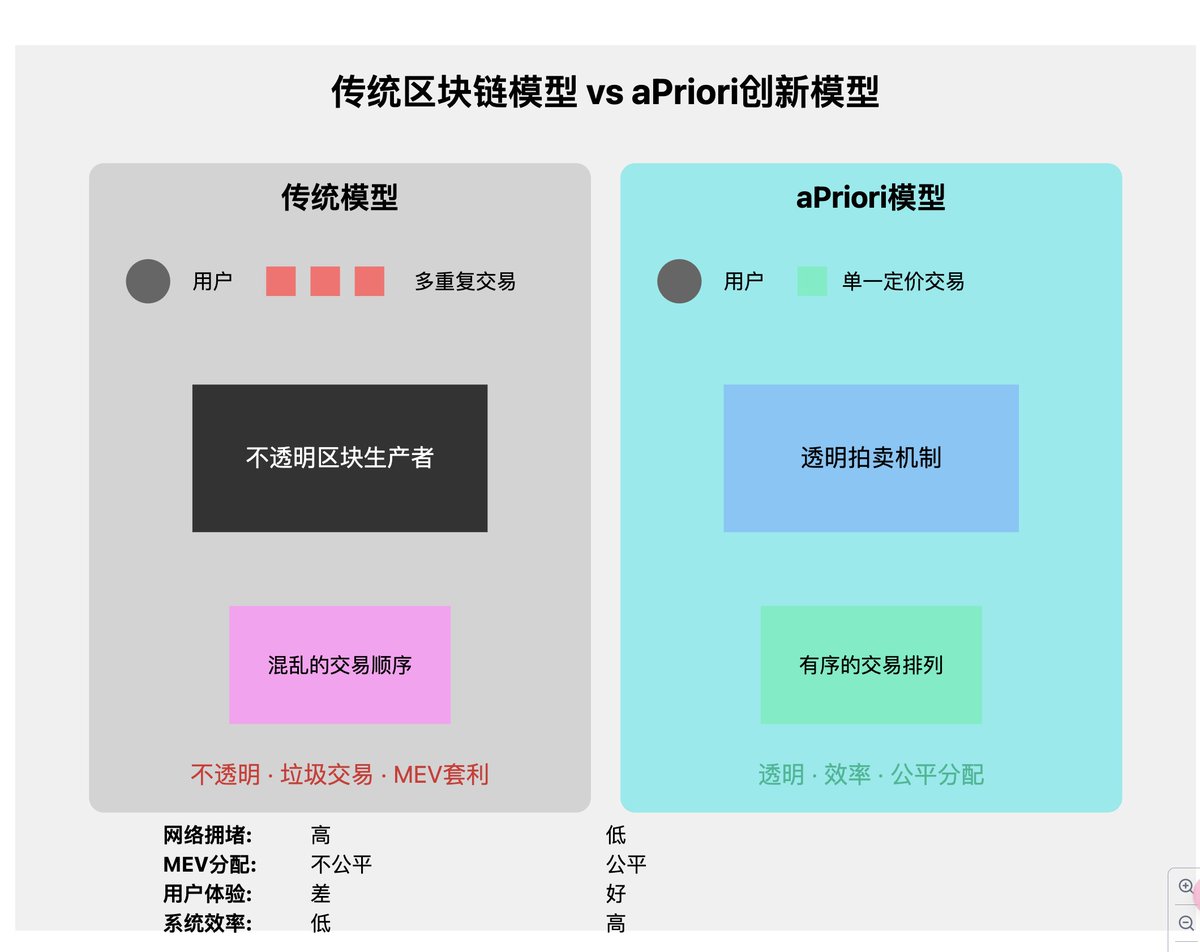Deep Understanding of aPriori's Game Model 🧙♂️
Imagine that the blockchain world is a huge auction house. Each block is an auction, and the block space is the auctioned item. In this auction house, there are three main roles: users (including regular users and MEV seekers), block producers, and token holders.
The goal of the Monad ecosystem's LST&MEV protocol Priori @aPriori is to design an auction mechanism that makes this auction house operate more efficiently and fairly.
1⃣ The Dilemma of Traditional Block Space Auction Models
In traditional blockchain models, this "auction" process is opaque. Block producers can freely decide which transactions are included and their order. This leads to two main problems:
Garbage transactions caused by MEV: MEV seekers send a large number of duplicate transactions, hoping to seize advantageous positions.
Opaque value extraction: Block producers may abuse their power to gain additional benefits by manipulating transaction order.
Let’s describe this problem using a mathematical model:
Assume seeker Si sends ni duplicate transactions, each with gas usage gi and gas price φi. If successfully executed, a reward R can be obtained. Then the expected profit for the seeker is:
E[πi] = pi * (R - φi * gi) - (1 - pi) * (ni * gi * δi)
where pi is the probability of at least one transaction being included, and δi is the cost of transaction failure.
In this model, seekers are incentivized to send a large number of duplicate transactions (increasing ni) to improve pi, leading to network congestion and resource waste.
2⃣ aPriori's Innovative Model
aPriori introduces a structured auction mechanism that fundamentally changes this game model. Let’s see how it works:
- First-price sealed auction:
Each user (including seekers) only needs to submit a single bid b_i, rather than multiple duplicate transactions.
- Bidding strategy:
In this model, the expected profit for users becomes:
E[πi] = (bi / B) * (R - bi - φi * g_i)
where B is the total bid amount required to ensure inclusion.
- Optimal bid:
By solving ∂E[πi] / ∂bi = 0, we can derive the optimal bid:
bi = β * ((R - φi * g_i) / 2)
where β is a bidding factor (0 < β < 1) that reflects the competitive environment.
3⃣ Model Comparison
- Reduction of garbage transactions:
In the aPriori model, sending multiple duplicate transactions no longer increases the probability of inclusion. Instead, users are incentivized to submit a carefully calculated bid.
- Efficiency improvement:
In the traditional model, seekers may waste a lot of resources on transactions that are not included. In the aPriori model, resource usage is more efficient.
- Fairness in value capture:
The aPriori model makes the distribution of MEV more transparent and fair. Block producers can no longer arbitrarily manipulate transaction order to extract value.
- Dynamic balance:
The bid bi is dynamically adjusted based on potential profit R and cost φi * g_i, reflecting real market demand.
4⃣ A Specific Example
Let’s illustrate the power of this model with a simplified numerical example:
Assume there is an MEV opportunity with potential profit R = 1 ETH.
Traditional model:
- Seekers may send 100 transactions, each with a gas cost of 0.005 ETH
- Total cost: 100 * 0.005 = 0.5 ETH
- Even if successful, the net profit is only 0.5 ETH
aPriori model:
- Seekers calculate the optimal bid: bi ≈ 0.4 ETH (assuming β = 0.8, φi * g_i = 0)
- If they win the auction, the actual payment may be slightly higher than the second-highest bid, say 0.3 ETH
- Net profit: 1 - 0.3 = 0.7 ETH
Not only has the seeker’s profit increased, but the entire network has also become more efficient by avoiding 99 useless transactions.
5⃣ Deep Reflection
The aPriori model is not just a technical innovation; it represents a profound insight into blockchain economics:
- The power of information:
By introducing structured auctions, aPriori makes hidden value information explicit and quantifiable. This reduces information asymmetry and improves market efficiency.
- The art of incentives:
Good economic design does not dictate what is "right," but creates an environment where "doing the right thing" becomes the best choice for each participant.
- System thinking:
The aPriori model considers the entire ecosystem, optimizing not just individual transactions but also the overall value creation and distribution process of the network.
- Adaptability and evolution:
This model leaves room for future innovations. As market conditions change, parameters like β can be dynamically adjusted to maintain system optimality.
Conclusion
The aPriori game model demonstrates the importance of economic thinking in blockchain design. It not only addresses the current MEV problem but also provides a framework for building a fairer and more efficient digital economic system.
As developers, users, or investors, understanding these underlying economic mechanisms is becoming increasingly important. In this rapidly evolving crypto world, true value comes not only from technological innovation but also from a deep understanding of human behavior and economic incentives.
The end.

免责声明:本文章仅代表作者个人观点,不代表本平台的立场和观点。本文章仅供信息分享,不构成对任何人的任何投资建议。用户与作者之间的任何争议,与本平台无关。如网页中刊载的文章或图片涉及侵权,请提供相关的权利证明和身份证明发送邮件到support@aicoin.com,本平台相关工作人员将会进行核查。




